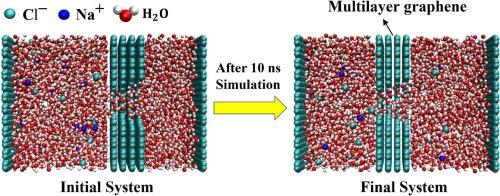通过多层氧化石墨烯膜的锥形纳米通道,在水渗透性和排盐性之间进行权衡,提高脱盐性能
IF 9.8
1区 工程技术
Q1 ENGINEERING, CHEMICAL
引用次数: 0
摘要
反渗透(RO)海水淡化以其卓越的能源效率和卓越的净化效果而闻名,已成为缓解淡水短缺的关键技术。石墨烯基膜被认为是RO脱盐实施的主要候选者,因为它具有显著的透水性。在此,我们提出了一种多层氧化石墨烯膜的锥形纳米通道,通过平衡水渗透性和排盐性来提高海水淡化性能。通过分子动力学(MD)模拟研究了纳米通道几何形状和氧化位置对水通量和水分子运输的影响。结果表明,与圆柱形纳米通道相比,锥形纳米通道的水分子渗透能垒较低,约为3.2 kJ/mol,水通量最大增加约80%。氧化石墨烯不仅吸引水分子,而且降低了水进入/退出通道的能量障碍,同时发挥了离子排斥作用。具体来说,带有最后一层氧化石墨烯(CyC-LGO)的锥形纳米通道在提高离子截留率的同时保持了较高的水通量。这些发现为调节离子和水分子的运输提供了重要的见解,为改善反渗透膜的水渗透性和盐排斥提供了重要的意义。本文章由计算机程序翻译,如有差异,请以英文原文为准。

Improving the desalination performance through conical nanochannels of multilayer oxidized graphene membranes by making a trade-off between the water permeability and salt rejection
Reverse osmosis (RO) desalination, renowned for its exceptional energy efficiency and superior purification efficacy, has emerged as a pivotal technology for mitigating freshwater deficits. Graphene-based membranes are recognized as prime candidates for RO desalination implementation due to its remarkable water permeability characteristics. Herein, we propose a conical nanochannel of multilayer oxidized graphene membranes to improve desalination performance by balancing water permeability and salt rejection. Molecular dynamics (MD) simulations were conducted to investigate the effects of nanochannel geometry and oxidation positions on water flux and water molecular transport. The results demonstrate that conical nanochannels exhibit lower energy barriers of approximately 3.2 kJ/mol for water molecule permeation compared to cylindrical nanochannels, with a maximum increase in water flux of approximately 80 %. Oxidized graphene not only attracts water molecules but also reduces the energy barriers for water entry/exit from the channels, while simultaneously exerting ion rejection effects. Specifically, the conical nanochannel with the last-layer oxidized graphene (CyC-LGO) maintains high water flux while improving ion rejection rates. These findings provide critical insights into regulating ion and water molecular transport, offering significant implications for improving the water permeability and salt rejection of reverse osmosis membranes.
求助全文
通过发布文献求助,成功后即可免费获取论文全文。
去求助
来源期刊

Desalination
工程技术-工程:化工
CiteScore
14.60
自引率
20.20%
发文量
619
审稿时长
41 days
期刊介绍:
Desalination is a scholarly journal that focuses on the field of desalination materials, processes, and associated technologies. It encompasses a wide range of disciplines and aims to publish exceptional papers in this area.
The journal invites submissions that explicitly revolve around water desalting and its applications to various sources such as seawater, groundwater, and wastewater. It particularly encourages research on diverse desalination methods including thermal, membrane, sorption, and hybrid processes.
By providing a platform for innovative studies, Desalination aims to advance the understanding and development of desalination technologies, promoting sustainable solutions for water scarcity challenges.
 求助内容:
求助内容: 应助结果提醒方式:
应助结果提醒方式:


